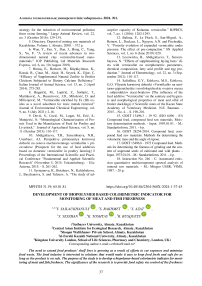Development of biopolymer based colorimetric indicator for monitoring of meat and fish freshness
Автор: Sailaukhanuly Y., Rakhmet S., Azat S., Yeszhan Y., Toshtay K., Busquets R.
Журнал: Вестник Алматинского технологического университета @vestnik-atu
Рубрика: Технология пищевой и перерабатывающей промышленности
Статья в выпуске: 1 (143), 2024 года.
Бесплатный доступ
The need to extend food products' shelf lives is growing as a result of efforts to cut expenses and minimize food waste. The food industry is interested in solutions that would make it easy to keep food fresh and safe for as long as the product is on sale. The purpose of the study is to develop a biopolymer-based colorimetric indicator for monitoring of meat and fish freshness. The significance of the research is to provide food safety via control of the freshness using green and cheap methods. The objects of the study are natural and artificial indicators. The paper presents natural indicators such as curcumin, pomegranate, beetroots, and carrot juice which were incorporated into the compositions of food freshness indicators. The obtained indicators were compared with an artificial indicator, bromothymol blue, and phenol red, concerning their volatile amine monitoring. Additionally, a model of volatile amine release based on the different ammonia solutions was applied in the research. The response of freshness indicators was estimated by the observation of color changes. Compared to the artificial indicators, the curcumin and pomegranate juices gave a similar response. Beetroot and carrot juices did not provide a desirable color change. Further research was made on the development of biopolymer containing freshness indicators based on bromothymol blue and phenol red. The indicators were evaluated for their response to the spoilage of fish and meat samples in the test tubes and in food packaging. Thus, two artificial indicators could be incorporated into effective food freshness indicators for smart packaging.
Meat, fish, food spoilage, indicator, biopolymer
Короткий адрес: https://sciup.org/140304541
IDR: 140304541 | DOI: 10.48184/2304-568X-2024-1-37-45
Список литературы Development of biopolymer based colorimetric indicator for monitoring of meat and fish freshness
- Mustafa F., Andreescu S. 2018, Chemical and Biological Sensors for Food-Quality Monitoring and Smart Packaging. Foods, Vol. 7, No. 168; https://doi.org/10.3390/foods7100168
- Xiaoshuan, Z., Gege, S., Xinqing, X., Yuanrui, L., Xiaoping, Z. 2016, Application of microbial TTIs as smart label for food quality: response mechanism, application and research trends, Trends in Food Science & Technology, Vol. 51, R.R 12-23, https://doi.org/10.1016/j.tifs.2016.02.006.
- Tichoniuk M., Radomska N., Cierpiszewski R. 2017, The application of natural dyes in food freshness indicators designed for intelligent packaging. Studia oeconomica posnaniensia, vol. 5, no. 7 https://doi.org/10.18559/SOEP.2017.7.2
- Tichoniuk M. Application of Smart Packaging for Enhancing Food Quality and Safety. 15th International Commodity Science Conference. Poznań https://doi.org/10.13140/RG.2.2.28844.72326 Tichoniuk M. 2019.
- Thirupathi Vasuki M., Kadirvel V., Pejavara Narayana G. 2023, Smart packaging-An overview of concepts and applications in various food industries, Food Bioengineering, Vol.2, P.25-41 https://doi.org/10.1002/fbe2.12038
- Smolander M. 2008, Freshness Indicators for Food Packaging. Smart Packaging Technologies for Fast Moving Consumer Goods Edited by Joseph Kerry and Paul Butler. John Wiley & Sons, Ltd, https://doi.org/10.1002/9780470753699.ch7
- Bevilacqua A., Corbo M.R., Sinigaglia M. 2017, The Microbiological Quality of Food: Foodborne Spoilers. Nikki Levy, 310 p. https://doi.org/10.1016/C2014-0-04133-0
- Sailaukhanuly Y., Kenessov B., Amutova F. 2013. Concentrations of organochlorine pesticides in food samples taken from markets in Kazakhstan by optmized GC-MS method. Abstracts of 245th ACS National Meeting. New Orleans, AGFD-206.
- Erkmen O., Bozoglu T.F. Food Microbiology: Principles into Practice. John Wiley & Sons, Ltd, 2016, 458 p. https://doi.org/10.1002/9781119237860
- Al Bulushi I., Poole S., Deeth H.C., Dykes G.A. 2009, Biogenic amines in fish: Roles in intoxication, spoilage, and nitrosamine formation-a review. Critical reviews in food science and nutrition. 49, 369-377. https://doi.org/10.1080/10408390802067514
- Nychas G.-J. E., Skandamis P. N., Tassou C. C., and Koutsoumanis K. P. Meat spoilage during distribution, Meat Science, Vol. 78(1-2), 2008, P.R. 77-89, https://doi.org/10.1016/j.meatsci.2007.06.020
- Gopakumar, K. 2000, Enzymes and Enzyme products as Quality Indices. Seafood Enzymes, Harrd N.F and Simpspn, B.K., (Eds). Marcel Dekker, Inc. New York, Basel, U.S.A. PP 337-363. https://doi.org/10.1201/9781482289916
- Luo Q., Hossen A., E Sameen D., Ahmed S., Dai J., Li S., Qin W., Liu Y. 2023, Recent advances in the fabrication of pH-sensitive indicators films and their application for food quality evaluation. Critical reviews in food science and nutrition. 63 (8), 1102-1118. https://doi.org/10.1080/10408398.2021.1959296
- Kunarbekova M., Shynzhyrbay K., Mataev M., Bexeitova K., Kudaibergenov K., Sailaukhanuly Y., Azat S., Askaruly K., Tuleshova Ye., Zhantikeyev S.U., Ybyraiymkul D. 2023. Biopolymers synthesis and application Materials Today: Proceedings https://doi.org/10.1016/j.matpr.2023.02.367
- Azat S., Zhantikeyev U., Askaruly K., Bexseitova K., Sailaukhanuly Y., Toshtay K., Tauanov Z., Ybyraiymkul D. 2023. Synthesis Nanoparticals of SiO2 From Rice Husk and Its Industrial Application. Diversity and Applications of New Age Nanoparticles https://doi.org/10.4018/978-1-6684-7358-0


